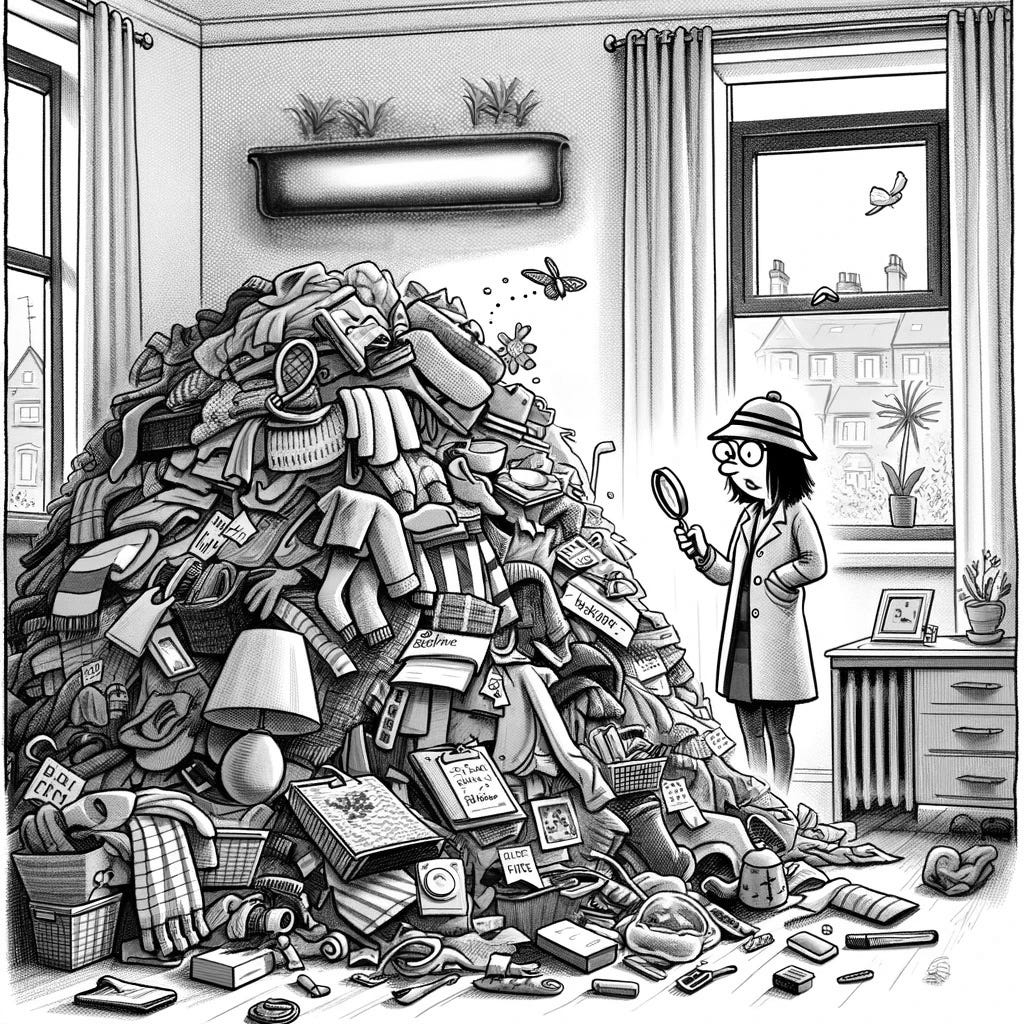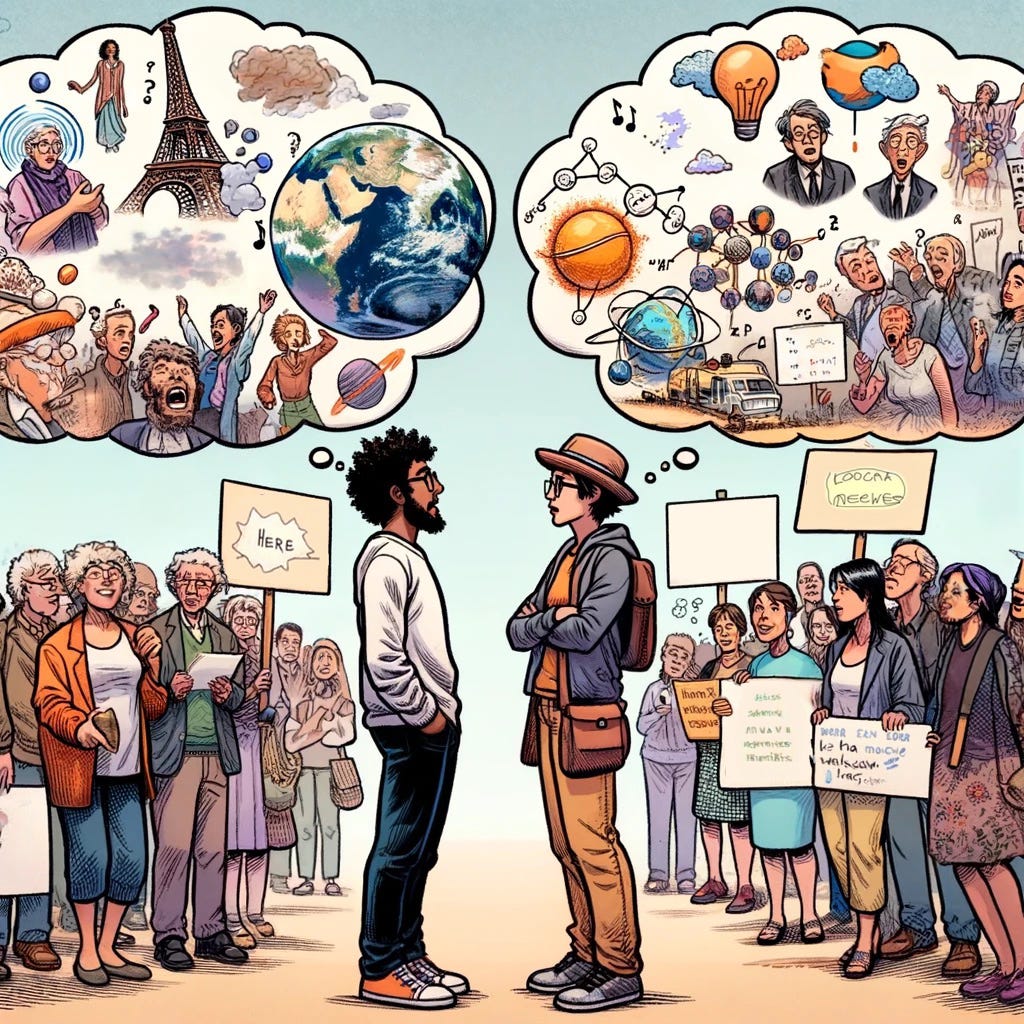NAPA VALLEY, Calif. — Some people get spring fever when April approaches, but I always get the urge to clean. Maybe it has something to do with all those years of helping my mother do what people used to call spring cleaning. With the first hint of warm weather, she hauled the furniture out onto the lawn, beat the rugs, waxed the floors, and was exhausted and thrilled at the end of the day.
It might also have to do with the COVID lockdown, when, like thousands of other people stuck inside their homes, my husband and I decided to do what we came to call the Great April Cleanout. The project lasted for six months, finally ending on the last day of September. In between we went full-on Marie Kondo, removing the contents of every drawer, closet and cupboard and considering whether the items brought us joy.
But what really got me off the peg was reading a little book by Oregon writer Francine Jay called “The Joy of Less: A Minimalist Guide to Declutter, Organize, and Simplify.” I’ve read lots of books about how to achieve an orderly and serene home, but this one stopped me in my tracks with its philosophical approach to what my British friends call “clearing out.”
The part that motivated me to use my spare time for six solid months going through everything I owned (and roping my husband in with me) was when she asks if someone else can use what we don’t. That gives a whole different slant to getting rid of “stuff.” If my trash is someone else’s treasure, why not let them give it a home? That idea set the scene for all those days of sorting – and made them satisfying and fun.
We started with holiday decorations and extras of several years’ worth of cards. I called a memory-care facility in my town and asked if they could use them. The woman in charge happily accepted the donations, and when I dropped them off, she told me that the residents would use my cards to communicate with people they loved. I practically danced back to my car.
Next came long-unused massage paraphernalia — a small microwave oven for warming towels and a hot-stone heater complete with stones — that I offered to the owner of the spa where I now get professional massages. It turns out the therapists who work there couldn’t schedule back-to-back hot-stone appointments because of the time needed to sanitize their equipment. My contribution, she told me, would provide a “floater” they could all share. It would enable them to say yes to clients they might otherwise have had to turn away.
I could tell stories like this all day. It turned out people had uses for our castoffs that we couldn’t have imagined. Perhaps most pleasurable of all was turning our laundry room/mudroom into a free store where we invited everyone who visited us to shop. We had duplicates of many items because of combining households when we married, so those were the first to go out onto the counter. A newly single carpenter who was doing some work at our house was furnishing his apartment from scratch, and once we knew that, it was easy to say goodbye to our extras. Later he told us that we had completely outfitted his kitchen.
My cousin was on the verge of replacing her rusty cooling racks when she came across my seldom-used ones. A young friend who was planning a trip to Mexico with friends but had no luggage got tears in her eyes when she spotted my old suitcases. Someone else’s grandmother collects miniature boats, so she gave a new home to a souvenir I had brought back from Wales. The piano tuner – also a piano teacher – was able to use the books of scales that I never planned to open again.
Our project gained momentum. With every happy customer who walked away we brought out more items we knew we could do without. Old games and puzzles, classic magazines, one-use appliances — out they went. When we finished with the house, we did the same thing in our garage and cleaned out our cars.
A New York Times essay by Ann Patchett called “My Year of No Shopping” was an influence when it came to tackling the clothes. I donated what I never wore to a thrift shop, and then I arranged my closet by color and now “shop” there when I need something to wear. In her essay, Patchett recalls frantically looking for a dress because she was going to introduce Tom Hanks at an event. After wasting two days going from store to store, it occurred to her that neither Hanks nor anyone in the audience had ever seen anything she owned and wouldn’t remember what she had on the next day anyway.
Which leads to another big question Jay raises in her book. Why are we buying all of this stuff in the first place? Who do we think will care if we have trendy clothes, a new car or the latest phone? Reading that made me as giddy as watching people leave my house with their arms full of my belongings.
The people who benefitted from our cleaning spree delighted us, but they aren’t the ones who reaped the greatest rewards. With empty drawers and shelves, no need to dig through piles of T-shirts and pans to find the one we want, no one to impress and no need to buy something new instead of using what we already have, we are free.
Levity Corner
Caption contest. Pick your favorite caption or add your own in the comments below
Vote for your favorite in the poll below (there’s not enough room in the polls for the complete answers).
The search for inner peace will begin after I unearth my yoga mat.
Now, where did I leave that book on tranquility?
The case of the missing calm: Suspect last seen beneath the avalanche of “I might need it someday.”
After the Great Declutter, peace of mind was found — along with the TV remote.
Other. Please include your own caption in the comments below.
Last week
Last week’s caption contest winners (Source):
“So, what’s going on in your neck of the woods?” with 39% of the votes
Top-three reader-suggested captions included:
Kathy Oates: “Want to grab lunch and talk about the planet?”
Ellen Sabine: “How can we work together?”
Katie Somple: “Hardware stores sell pies now.”
Last Week @ Napa Valley Features
In "Dan Berger’s Varietal Views: Sauvignon blanc," Berger examined the rise of sauvignon blanc, a once underappreciated grape now rivaling chardonnay in popularity, especially in U.S. restaurants. He contrasted its herbal qualities with riesling's floral notes, explored regional variations, including the Loire Valley and California, and discussed its diverse styles, such as New Zealand's distinctive sweet versions. Berger also noted the grape's aging potential, emphasizing its growing global presence and varied characteristics.
In his article "Pruning and climate adaptation tips for home vineyards in Napa Valley," David Layland emphasized the importance of adapting vineyard practices in response to climate change. He advised on soil health, using cover crops and compost, and discussed effective irrigation and pruning strategies. The article also highlighted the need to address powdery mildew, informed by recent genetic research, and concluded with an invitation to a Master Gardener workshop for more detailed vineyard management insights.
Dave Stoneberg's article "Spectacular Warrior Dogs exhibit continues at Napa Valley Museum Yountville" highlights the ongoing "Warrior Dogs" exhibit, which honors military working dogs' service and sacrifice. The exhibit, ending Aug. 25, features photographs, equipment and 17 wooden sculptures by James Mellick, including a representation of Cairo, a dog from SEAL Team Six's mission against Osama bin Laden. It explores the evolving role of military dogs and their impact, both historically and emotionally, particularly for those with military connections.
In the article "Lynne Champlin: from flight attendant to beloved Napa Valley storyteller," Sasha Paulsen and Lynne Champlin explore Champlin's evolution from a flight attendant to a cherished local columnist in Napa Valley. Despite initially not considering herself a writer, Champlin's storytelling prowess has shone through in her "Coffee, Tea and Me" column, drawing on her life experiences and local tales. Her writing, often inspired by her travels with her late husband Philip, resonated with readers, showcasing her innate ability to engage and connect through her stories. Champlin's continued passion for writing and storytelling, even after personal loss, highlights her significant role in the Napa community.
In "Sunday E-dition: Napa Valley Features is online news, features and information source," Dave Stoneberg recounted the shift from traditional print journalism to digital platforms, focusing on the challenges faced by local newspapers, including dwindling ad revenue and rising costs. He shared his experience transitioning to writing for Napa Valley Features, an online news service that combines free and subscriber-only content. Emphasizing a public-radio model, the platform depends on community support and subscriber contributions for quality local journalism. Stoneberg highlighted the importance of supporting Napa Valley Features as a paid subscriber to ensure its continuation, noting the service's success and growth, with nearly 3,500 subscribers and a wide range of local stories.
In the article "Under the Hood: The End of Tourism as We Know It," Tim Carl analyzed the future of luxury tourism, particularly in Napa Valley, amidst changing global economic and demographic landscapes. He discussed how Napa Valley, known for its viticulture and luxury tourism, faces challenges due to shifts in wine consumption and evolving generational preferences. Key insights included the contrasting travel and consumption patterns of those over 55, who favor traditional luxury, and the under-55 group that seeks value and variety. Carl highlighted how economic trends and technological advancements are affecting the labor market and, consequently, travel preferences. The article also delved into the real estate market's complexities and the "wealth effect," showing how perceived financial stability influences consumer behavior differently across age groups. Carl concluded that Napa Valley's future success in luxury tourism will depend on understanding and adapting to these shifts. The article, part of the paid subscription series "Under the Hood," offered detailed analysis and insights, underscoring the importance of supporting Napa Valley Features as a paid subscriber to access such in-depth local journalism.
Next Week @ Napa Valley Features
Next week, Napa Valley Features' contributors will present a range of engaging topics. Stoneberg will tell us about rare cars such as the 1939 Alfa Romeo at the Sonoma Raceway, while Mariam Hansen will spotlight the honor given to Chinese laborers through a memorial monument. The Master Gardener series will continue its exploration of local horticulture. On Thursday, Berger will offer insights on sangiovese varietals in his column. The Weekender promises to guide readers through the valley's upcoming events and activities, and Carl will provide an in-depth look at how shifting demographics are poised to have significant economic impacts in the "Under the Hood" series. And there’s more, too!
If today’s story captured your interest, explore these related articles:
Glenda Winders is a novelist, freelance writer and copyeditor for Napa Valley Features.
"Rupert" is a comic series by Kathleen Scavone. Enjoy this clever and thoughtful work from a talented artist and writer.










I think no one else commented because cleaning can be so shaming. (Obviously I have no shame.) When the pandemic hit, I counted up the drawers in my house--52--and said, “I shall clean/tidy one a week for a year!” Didn’t happen. It was a combination of indolence and an aversion to adding to the landfill. Community Projects was closed, too, so I couldn’t take clothes there. I worked in my yard instead.